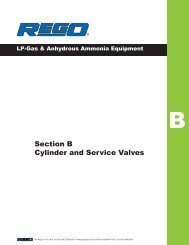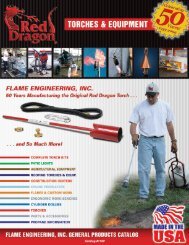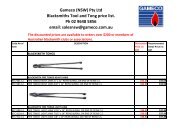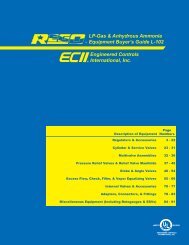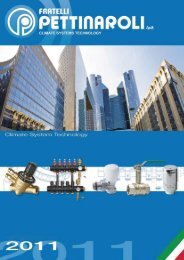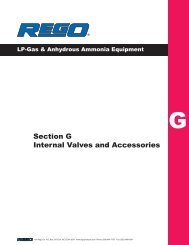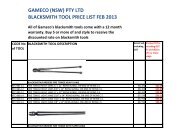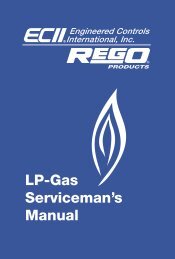Repair Kits Available By Part Number Section 2 Page - GAMECO
Repair Kits Available By Part Number Section 2 Page - GAMECO
Repair Kits Available By Part Number Section 2 Page - GAMECO
Create successful ePaper yourself
Turn your PDF publications into a flip-book with our unique Google optimized e-Paper software.
WARNING: Installation, disassembly, repair and maintenance must<br />
be performed only by qualified personnel.<br />
Complete maintenance should be performed only after all gas has<br />
been evacuated from the system and container. Remove the entire<br />
valve before performing repairs.<br />
Emergency service, on the actuator and lower stem assembly portion<br />
of the valve only, may be carried out with the valve installed,<br />
provided downstream pressure is relieved under the same conditions<br />
required for releasing LP-Gas, as in the caution below. There<br />
must be positive assurance that the valve is closed tight with no<br />
leakage past the seats.<br />
Installation, usage and maintenance of this product must be in<br />
compliance with all Engineered Controls International, Inc. instructions<br />
as well as requirements and provisions of NFPA #54, NFPA<br />
#58, DOT, ANSI, all applicable federal, state, provincial and local<br />
standards, codes, regulations and laws.<br />
Inspection and maintenance on a periodic basis is essential.<br />
Be sure all instructions are read and understood before installation,<br />
operation and maintenance. These instructions must be passed<br />
along to the end user of the product.<br />
CAUTION: Contact or inhalation of liquid propane, ammonia and<br />
their vapors can cause serious injury or death! NH3 and LP-Gas<br />
must be released outdoors in air currents that will insure dispersion<br />
to prevent exposure to people and livestock. LP-Gas must be<br />
kept far enough from any open flame or other source of ignition to<br />
prevent fire or explosion! LP-Gas is heavier than air and may not<br />
disperse or evaporate rapidly if released in still air.<br />
DISASSEMBLY AND REPAIR PROCEDURE<br />
CAUTION: READ THROUGH ALL OF THESE INSTRUCTIONS, IN-<br />
CLUDING THE NOTICE AND WARNINGS ON THE BACK OF THIS<br />
SHEET, BEFORE BEGINNING ANY DISASSEMBLY OR REPAIR.<br />
NOTE: Before repairing valve, thoroughly examine valve lever and all<br />
associated parts for excessive wear. Check handle for proper function<br />
and flange seating surfaces for excessive wear and damage. Any<br />
components that are not in good condition and not fully operational<br />
should be replaced during repairs.<br />
<strong>Repair</strong>s must be performed in a clean area. Hands, clothing, tools and<br />
work area must be completely free of oil, grease and foreign matter to<br />
prevent contamination of component parts and valves.<br />
MANUAL / PNEUMATIC ACTUATOR DISASSEMBLY<br />
NOTE: The Standard A3219F Series is equipped with a manual actuator.<br />
It is possible that the valve under repairs has been fitted with<br />
a A3219FPA pneumatic actuator. Please follow the disassembly and<br />
reassembly procedures for the appropriate actuator.<br />
Manual Actuator Removal<br />
A. Handle Removal<br />
1. Remove cotter pin from jam pin which is located below the handle.<br />
Discard cotter pin.<br />
2. Loosen jam nut and run it down so that it just overhangs the end<br />
of the jam pin.<br />
3. Vertically, tap the end of the jam pin with a hammer to loosen. Raise<br />
the jam pin as far as possible and pull the handle off the stem. It<br />
may be necessary to remove the nut from the jam pin so that the<br />
jam pin may be raised enough in order to remove the handle. Retain<br />
all parts.<br />
4. Remove the bumper and stop screw from the handle. Retain the<br />
handle and discard the bumper and stop screw.<br />
B. Release Lever and Channel Spacer Removal<br />
1. Working through the holes in the release lever with a 9 /16" thin wall<br />
socket, remove the two (2) channel screws. The release lever assembly,<br />
lever release spring, channel spacer and fuse assembly<br />
can be removed. Retain all parts.<br />
NOTE: If the proper 9 /16" thin wall socket is not available, the pivot pin,<br />
pivot pin locknut and pivot pin washer will have to be disassembled<br />
before removing the channel screws.<br />
2. Hold the hex of the pivot pin with a wrench and remove the pivot<br />
pin locknut. Discard the locknut.<br />
3. Disassemble the pivot pin, pivot pin washer, channel and release<br />
lever. Retain all parts.<br />
4. Remove the collar and collar washer from the valve stem and<br />
retain.<br />
A3219F-80G <strong>Repair</strong> Kit for<br />
A3219F Series 4" Internal Valves<br />
With Gasket Flange Seals<br />
Pneumatic Actuator Removal<br />
1. Remove the cotter pin from the pivot pin, located behind the<br />
clevis, and discard. Remove the pivot pin and pivot pin washers<br />
and save.<br />
2. To remove the crank arm, loosen and remove the jam screw and<br />
jam nut. With a punch and hammer, tap the end of the jam pin from<br />
the underside to loosen. Raise the jam pin as far as possible and<br />
pull the crank arm off the stem. Retain all parts.<br />
3. Remove and retain the collar and collar washer.<br />
4. Remove and retain the bracket screws and bracket lockwashers.<br />
The actuator and bracket can now be removed and saved.<br />
VALVE DISASSEMBLY<br />
Roller Actuator/Stem Assembly<br />
1. Remove the cotter pin from the jam pin located in the roller actuator<br />
inside the valve outlet port. Discard the cotter pin.<br />
2. Loosen the jam nut on the jam pin.<br />
3. Push the jam pin in as far as possible and remove the roller actuator<br />
assembly by sliding it off the stem. Save all parts.<br />
4. Remove the cotter pin from the roller pin. Discard the cotter pin.<br />
5. Remove the roller pin from the roller actuator and remove the roller.<br />
Save these parts.<br />
6. Using a 1 3 /8" wrench, completely loosen and remove the seal gland.<br />
Remove the entire seal gland and stem assembly from the valve.<br />
7. Carefully remove the seal gland from the stem so as not to damage<br />
any of the parts, especially the stem.<br />
8. Remove the stem washer, stem seal spring, stem jam ring and<br />
three (3) stem seal rings from the seal gland. Be careful not to nick<br />
or scratch the inside surface of the seal gland. Discard all parts<br />
except the seal gland, stem washer and stem seal spring.<br />
9. Remove the stem o-ring and outer stem bearing from the seal gland<br />
and discard. Remove and discard the dirt seal which is press fitted<br />
into the seal housing. Retain the seal gland and stem.<br />
10. Remove the seal gland gasket and inner stem bearing from the<br />
valve body and discard.<br />
11. Check the stem and seal gland for excessive wear and/or damage,<br />
especially in the sealing areas. Replace the stem with part number<br />
A3219-48 and the seal gland with part number A3219-53.<br />
Bonnet Assembly<br />
1. Remove the strainer screw, strainer top and strainer from the valve.<br />
Save these parts.<br />
2. Remove the eight (8) bonnet screws, one at a time, being sure that<br />
the last two (2) screws removed are directly opposite of each other.<br />
When removing these last two (2) screws, hold down on the bonnet<br />
as it is spring loaded. Remove the bonnet and poppet spring. Save<br />
these parts.<br />
3. Remove the poppet and stem assembly by lifting straight up on<br />
the upper stem. Place a large flat screwdriver into the slot of the<br />
upper stem. Move the poppet against the excess flow spring until<br />
the flats on the lower stem are exposed. Place a crescent wrench<br />
across the wrench flats of the lower stem and seperate the upper<br />
and lower stem. These are held together by a right-hand thread.<br />
Discard the molded stem seal and the stem o-ring.<br />
4. Remove the four (4) disc holder screws from the disc holder. Remove<br />
the main seat disc and discard.<br />
5. Remove the seat ring, seat seal o-ring and poppet bearing from<br />
the valve body. Retain the seat ring and discard the poppet bearing<br />
and seat seal o-ring.<br />
6. Remove and discard the upper flange seal gasket and lower flange<br />
seal gasket from the valve body.<br />
7. Check the poppet, disc seal retainer and seat ring for excessive<br />
wear. Replace if necessary with part number A3219-15N for the<br />
poppet. A3219-3A for the disc seal retainer and A3219-2 for the<br />
seat ring.



